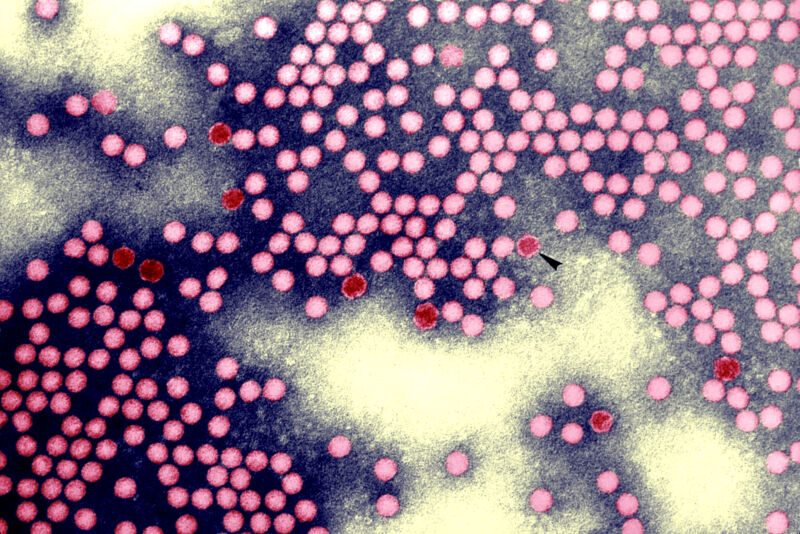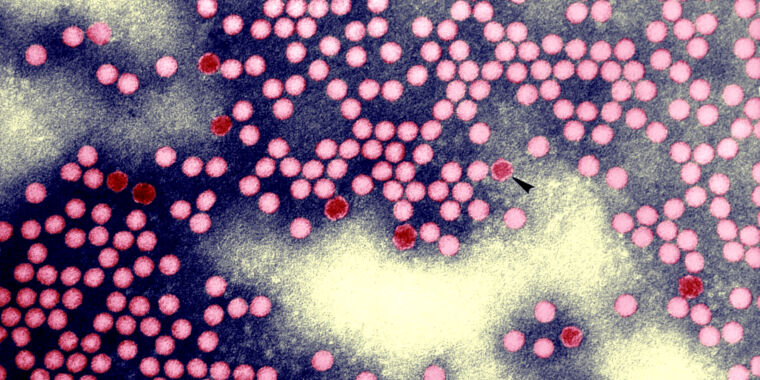
Health officials in New York are ramping up efforts to boost polio vaccination rates in local children as yet more poliovirus has surfaced in sewage sampling.
On Friday, August 12, New York state and New York City health officials announced that poliovirus had been detected for the first time in New York City sewage, suggesting local circulation of the virus.
The finding follows similar detections in sewage sampling in nearby Rockland and Orange counties during May, June, and July. On July 21, health officials in Rockland county reported a case of paralytic polio in a young, unvaccinated male resident who had not recently traveled out of the country. The man’s symptoms began in June.
The Centers for Disease Control and Prevention estimates that only about one in 200 people infected with poliovirus develop paralysis. Thus, the identification of the paralytic case last month indicates that hundreds of others could have also been infected. And, over time since the case’s onset, the cumulative total of cases may be in the thousands.
“For every one case of paralytic polio identified, hundreds more may be undetected,” New York State Health Commissioner Mary Bassett said in a statement. “The detection of poliovirus in wastewater samples in New York City is alarming, but not surprising.” New York City, state, and CDC officials are “responding urgently” and “aggressively assessing spread,” she added.
Circulating poliovirus is only a threat to those who are unvaccinated. Fortunately, most Americans are vaccinated and are, therefore, not at risk. The four-dose inactivated poliovirus vaccine is part of routine vaccination schedules in the US, and most children get the first three doses by 18 months. The fourth dose is given between the ages of 4 and 6. However, not all children are vaccinated, and there are pockets of some communities with low vaccination rates, including some in New York City and neighboring suburbs.
Risk and luck
In New York, 78.96 percent of children statewide received the first three doses by the age of 2. But, in Rockland County, the vaccination rate for children under 2 is only 60 percent. And in Orange County, it’s just under 59 percent in children under 2. The vaccination rate in New York City is higher, but officials say it’s been slipping since 2019. Currently, only 86 percent of NYC children under 5 years are fully vaccinated, meaning 14 percent are vulnerable to the dangerous disease.
“The risk to New Yorkers is real but the defense is so simple—get vaccinated against polio,” New York City Health Commissioner Dr. Ashwin Vasan said in a statement. “With polio circulating in our communities there is simply nothing more essential than vaccinating our children to protect them from this virus, and if you’re an unvaccinated or incompletely vaccinated adult, please choose now to get the vaccine. Polio is entirely preventable and its reappearance should be a call to action for all of us.”
New York officials aren’t the only ones scrambling to address a resurgence of poliovirus. Officials in the UK this week announced that they had detected 116 poliovirus isolates from 19 sewage samples in at least eight London boroughs since February. Officials are now working to vaccinate all children ages 1 to 9 across London.
“In London it is just good luck that nobody has been paralyzed from these viruses that have been picked up,” David Salisbury, WHO Global Commission for Certification of Polio Eradication, said in a statement. “Those who are vaccinated are well protected—it is those people who are unvaccinated or under-vaccinated who are at risk.”
In London and New York, officials have detected genetically linked isolates of vaccine-derived poliovirus (specifically vaccine-derived poliovirus type 2 or VDPV2), which stems from oral polio vaccines. These vaccines, which are no longer used in the UK and US, contain weakened, replicating viruses, and they are safe, effective, and affordable. But, if they’re given in areas with poor hygiene, improper sanitation, and low vaccination rates, the vaccine virus can spread, mutate, and regain the ability to cause disease and paralysis.








